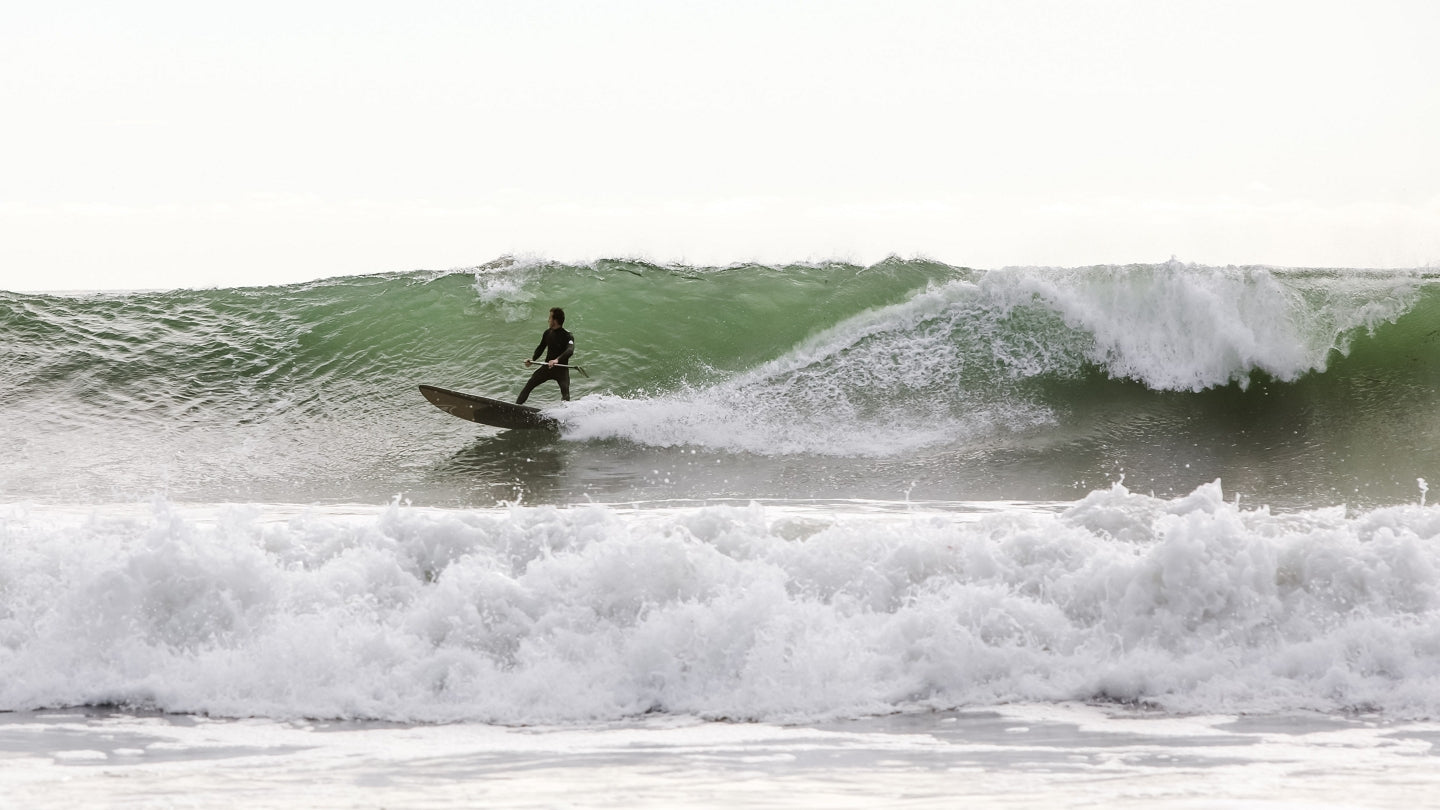SUP Surf 101: Everything You Need to Know!
At first glance, SUP surfing may seem much easier than old-fashioned surfing, but facing a wave standing up still remains quite the challenge. Depending on the conditions, you will notice that catching waves in SUP is not always as easy as it seems!
If your intentions are to slowly but surely migrate towards SUP surf, don’t panic! Here are a few applicable concepts for an efficient and safe SUP surf practice in the ocean.

Boards and Equipments
You can paddlesurf with practically any type of all-around board: everything truly depends on the size of the waves. With larger boards (10’-11’), you can have fun cruising on smaller waves of 1 to 2 feet, but for higher performance, we recommend boards measuring less than 9’6.
How to Choose the Right SUP Surf?
For an optimal feeling, there is a category specifically tailored to paddlesurf. The boards in this category generally have a design very similar to that of short surfboards, but with a larger volume. If we compare them to all around boards, they are sturdier, have more aggressive shapes and rails, possess a lower volume and thus less floatability, and have more rocker, making them much more manoeuvrable in the waves.
When it comes to the paddle, the regulars will prefer using a length much shorter than what they take during strolls. Why? Several reasons: more of a squatted position, board has lower volume and thus is much more submerged in the water, and much less cumbersome for quick turns in surf mode.
To see our paddles, click here!

Passing the Break
Board in-hand and leash on foot, you’re ready to rumble! First step: passing the break. Yes, it is probably the most difficult step. Contrary to surfing, where it is possible to duck dive under the waves, in paddleboarding, since the board is much more voluminous and floats more, we must pass the break above the surface of the water.
In the case where successive waves seem unachievable, wait until the ocean has become calm once again and paddle towards the line-up. By adopting this strategy, you will definitely move back towards the shore, but you will quickly realize that these episodes of successive waves (known as a ‘set’) are fleeting, and you will therefore tire yourself out much less. To maintain your energy levels and maximize your efficiency, here is our advice: learn how to paddle on your knees. This is the most efficient way to pass the break without draining all of your energy.

What Position to Choose When Travelling Through Waves?
Do I keep my feet parallel with each other or one in front of the other? Do I attack the wave face first or from the side? Here is our answer: If you position yourself face first, in a parallel position, you will be sturdy enough to go through the wave without falling. The important thing here is to perform a good squat the moment that wave hits your board. Definitely don’t lock your legs, as you are then guaranteed to fall.
With experience however, you will soon realize that the surfing position is much more advantageous than the typically adopted SUP position (parallel feet), especially when faced with larger waves. Placing one foot a little closer to the nose of your board, you will be able to conserve a sufficiently important amount of pressure at the front of your SUP. To do this, we recommend lowering your equilibrium center and giving a strong, hard paddle stroke right when the wave hits your board.
The key to success, we repeat: bending your knees significantly in order to avoid falling.

Waiting On and Catching Those Waves
The most popular technique to catch a wave adopted by beginners consists of paddling in a parallel position and then quickly switching to a surfing position. This technique works well, but to avoid falling, the switch needs to be extremely well executed. Our advice: Try to take on the wave in a surfing position, without any switches. With a little bit of practice, and getting used to the surfing position, you will become faster during your first turn (bottom turn).
Finally, to catch a wave, it is recommended to guide your board at an angle of 30 to 45 degrees. Taking on a wave in a straight line (at 90 degrees) could make you lose speed at the bottom of the wave. You would then have a hard time catching up with the shoulder, aka the surface part of the wave.

Photo : Phil Émond
Etiquette in the Line-up
We talk about this often, but let’s make one thing clear! Everyone has the right to surf in the ocean, but in such a risky context like surfing, everyone is also entitled to surf within a safe environment. This is why beginners are always recommended to find a section of waves (peak) slightly secluded from others. In other words, one should simply deter from areas filled with the majority of surfers, in order to keep a safe distance from them. This concept is especially important once we understand how vital the range of the board is when at the end of the leash. Certain paddlers can reach up to 20 feet in range (10 feet of board + 10 feet of leash). It is therefore crucial, once in the line-up, to understand the directional dynamic of the waves and other surfers. Mainly: avoid any impacts at all costs!
« Sharing is caring! »
It is possible, and completely normal, that other surfers fear getting hit by your SUP surfboard, and are therefore not exactly thrilled with your presence in the water. However, if you demonstrate good etiquette and manage to take on the waves safely and within your ability level, you will obtain the non-verbal approval of the others in the line-up. As we often say in this sport: Sharing is caring!
Finally, one of the most important notions of etiquette: do not ‘drop-in’. Let us explain. Essentially, a drop-in consists of taking a wave that is already in-use by another surfer. This type of action is strongly frowned upon. It puts you in danger, but also puts the already engaged surfer at risk of impact. Let us also mention that you have essentially ‘stolen’ another person’s wave…not cool! However, drop-ins are sometimes inevitable in the heat of the moment, and often happen without malicious intent. This is why, should you commit a drop-in, it is preferable to warn the affected surfer. A small hand signal to indicate your apologies and let them know that you understand what just happened is always appreciated.
On that note, happy paddlesurfing!
Discover our 5 Best SUP Surf Spots

